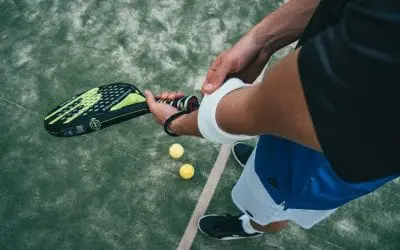The weather is finally warming up, you go through your daily routine of work, cleaning, and projects for the family home. After a productive day of physical tasks, you pick up your old racket and head to the courts to get back into the athletic shape that won you that intramural recreational league trophy back at University. You take one swing with your eye on the ball but a sharp pain around your elbow disrupts your focus and you miss. Tennis Elbow (15), You (love).
What is Tennis Elbow?
Despite the name Tennis Elbow, also known as Lateral Epicondylitis, the condition itself is not unique to the sport of Tennis. The condition is an inflammation of the tendons of the elbow which is caused by an overuse of the muscles of the forearm. This is an overuse disorder which causes minor trauma and commonly occurs in people performing an activity involving repeated flexion of the wrist.
Statistics of Tennis Elbow
- Typically affects middle aged adults (40 to 60 years of age)
- About 200,000 cases per year
- Affects up to 3% of the population
- Affects up to 50% of tennis players throughout their careers (hence the name)
- Men are more likely to be affected than Women
Tennis Elbow Symptoms
In most cases, pain on the outside of the elbow and sometimes in the forearm and wrist are the primary symptoms. In addition, people may experience other common symptoms such as swelling or tenderness within these areas. Pain and weakness on this area of the body may make it difficult to:
- Shake hands
- Grip objects
- Open doors with turning knobs
- Holding your favorite coffee mug
Causes of Tennis Elbow
Lateral Epicondylitis occurs when small tears start to develop on the outside of the elbow and sometimes in the forearm due to repeated wrist flexion. After several days, an ache develops from the tears and becomes the pain associated with the condition. Above all this is an overuse disorder. As a result, causes involve repeated forcible extension of the wrist with activities such as:
- Playing tennis
- Using a screwdriver
- Shoveling snow
How Do You Prevent Tennis Elbow?
Generally you don’t have to stop doing your favorite activities. However you may have to make adjustments if you hope to prevent this type of injury. If you think you may be at risk of this condition, you should use these preventative techniques:
- Spread the load of activity to the larger muscles of your shoulder and upper arm while avoiding dependence on your wrist and elbow
- Focus on form and techniques to reduce strains
- Warm up and stretch before activities and take proper breaks
- Increase the strength of your forearm muscles
If you have Tennis Elbow and would like to reduce further damage and pain, you should:
- Stop performing the activity that is causing pain
- Find an alternative way of doing the activity that doesn’t place stress on your tendons
- Wear a Tennis Elbow splint when you are performing activities using your arm
- Rest and possibly seek treatment depending on severity of pain
Tennis Elbow Treatments
Treatments for Lateral Epicondylitis can vary as the severity of the condition could vary as well. Luckily in most cases, Tennis Elbow heals on its own. With proper rest, icing of the area, preventative techniques, and taking of nonsteroidal anti-inflammatory (NSAIDs) such as ibuprofen, the pain can be manageable and start to recover. This process could take up to several months on it’s own.
Treatments – Physical Therapy
If pain persists, other active methods may be necessary. Usually it is advised to schedule a screening with a Physical Therapist. They specialize in the evaluation, assessment, and treatment of limitations in functional mobility such as Lateral Epicondylitis. Motion exercises will reduce stiffness and increase flexibility. Likewise, strengthening and stretching the muscles in a way that focuses on recovery and minimizing pain. Increased functionality will improve blood flow and make it easier for your arm to heal and build strength so you may never suffer from Tennis Elbow again. With direct access it’s easier then ever to schedule an appointment.
Treatments – Cortisone and Surgery
If your condition of Tennis Elbow has not healed after two to four months of treatment, you may need think of surgery as a solution. Cortisone shots are considered an option, however it is seen as a temporary treatment. Surgery is handled by removing the damaged section of tendon and repairing the remaining portion. This solution has a 85 – 90% success rate. However like any surgery it requires recovery time anywhere between 4 to 6 months.
Recovering from Tennis Elbow
People heal at different rates. In summary, you know you have made a full recovery and can return to former activities when:
- Gripping objects is no longer painful
- Injured arm feels as strong as your other arm
- Full range of arm motion and can flex without any trouble
You pick up your racquet and slam home an ace on your opponent, take a sip from your favorite coffee mug, and dust off that recreation league trophy to relive the glory days. You defeated Tennis Elbow. Game, Set, Match!
Sources & References
- https://www.myvmc.com/diseases/tennis-elbow-lateral-epicondylitis/
- https://www.assh.org/handcare/hand-arm-conditions/tennis-elbow
- https://www.painscience.com/articles/tennis-elbow.php
- https://www.mayoclinic.org/diseases-conditions/tennis-elbow/symptoms-causes
- http://www.assh.org/handcare/hand-arm-conditions/tennis-elbow
- Kumar P, Clark M. CLINICAL MEDICINE. WB Saunders 2002;
- Moore, KL, Clinically orientated anatomy 3rd ed; Williams and Wilkins, 1992;
- Murtagh, J. General Practice. Second Ed. McGraw-Hill, 1998
.png)



